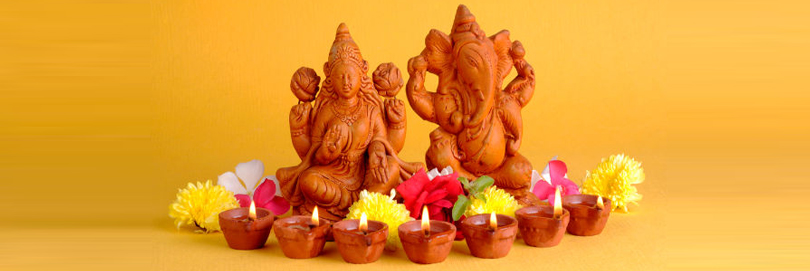Tradition of Diwali Pooja

The literal meaning of 'Diwali' in Sanskrit is 'a row of lamps'. The most popular tradition of Diwali is filling little clay lamps with oil and wick and lighting them in rows all over the house. Even today, the tradition projects the rich and glorious past of our country and teaches us to uphold the true values of life.
Diwali has many legends and religious accounts associated with it. Lights and diyas are lit to signifying the driving away of darkness and ignorance, as well as the awakening of the light within ourselves. It is the perfect time for family gatherings, foods, celebrations and pooja. Goddess Laxmi plays a major role in this festival, as do Ram and Sita. This autumn festival is a five-days celebration, of which each one has its own significance.
People renovate and decorate their houses and business places. Entrances are made colorful with lovely traditional motifs of Rangoli designs to welcome Laxmi, the Goddess of wealth and prosperity. To indicate her long awaited arrival, small footprints are drawn with rice flour and vermilion powder (kumkum) all over the houses. Lamps are kept burning all through the nights.
In order to welcome Goddess Laxmi, the house is kept clean and rangoli is drawn at the doorstep. A pandit is consulted for the best time of puja. The general things needed for a diwali puja are silver and gold coins, suparis, uncooked Rice, paan leaves, kumkum for applying tilak, mithaai (Indian sweets), camphor, agarbattis (incense sticks), dry fruit (almonds, cashews), flower petals and Lakshmi-Ganesh icon.
The pooja ritual is performed in the evening when tiny diyas of clay are lit to drive away the shadows of evil spirits. Bhajans are sung in praise of the goddess and sweets are offered to her. Diwali puja consists of a combined pooja of five deities: Ganesha is worshipped at the beginning of every auspicious act as Vighnaharta; Goddess Lakshmi is worshipped in her three forms Mahalakshmi,the goddess of wealth and money, Mahasaraswati, the goddess of books and learning and Mahakali. People also worship 'Kuber'- the treasurer of the gods.
- - Diwali Cards
- - Crackers
- - Dry Fruits
Festival Fun
- Diwali Rangoli
- Diwali Messages
- Diwali SMS
- Diwali Recipes
- Deep in Diwali
- Diwali Whatsapp Messages/Status
- Tradition of Playing Cards
- Pooja Thali Decorations
- Making Diwali Cards
- Diwali Essay
- Diwali Poems
- Diwali Songs
- Diwali Mela
- Diwali Wallpapers
- Diwali Decorative Items
- Diwali 2024
- Diwali Quotes
- Lakshmi Pooja
- Articles
- Lakshmi Ganesha Mantras
- Lakshmi Chalisa
- Diwali Solar Eclipse
- Diwali Remedies
- 108 Lakshmi Names
Diwali Rangoli
Indians love colors and its perfectly reflected in various ways. Rangoli is one such example that is a unique art work that is...Know More
Diwali in History
The history of Diwali is replete with legends and these legends are moored to the stories of Hindu religious scriptures...Know More
Diwali Messages
Enjoy the Best and the Most Heartfelt Diwali Messages from all entries received by us!!...Know More
Diwali Gift Ideas
Diwali is the epiphany of showing gratefulness to the almighty for blessing with wealth and wisdom. It is the time of illuminating...Know More





